Lal R., Shukla M.K. Principles of Soil Physics
Подождите немного. Документ загружается.

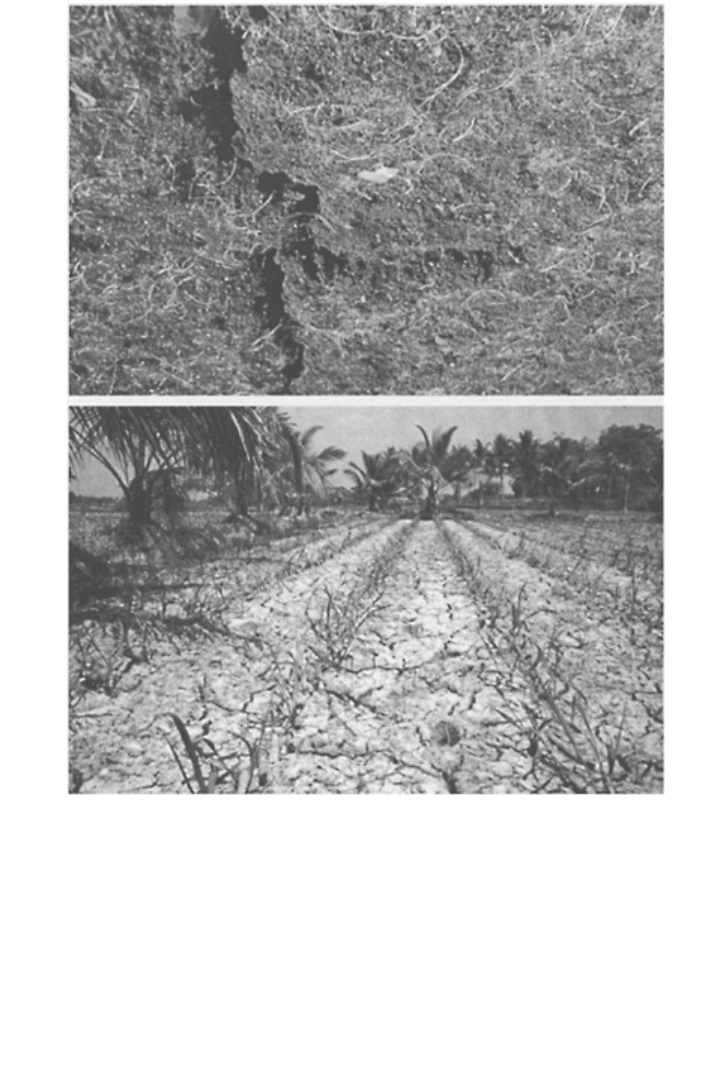
FIGURE 20.2 (a) Cracks in a vertisol
and (b) in a structurally unstable soil
conducting water rapidly until the
cracks are sealed. (Southern India,
2001.)
classification, the order level, in most classification systems. Although crack volume
decreases on rewetting, cracking is not a fully reversible phenomenon. Once a desiccation
crack has been formed in an uncompacted soil, it cannot be removed by rewetting, since
the particles on the edge of the crack change their orientation. The same phenomenon
Principles of soil physics 584

was also observed in compacted clays and in field soils, respectively (Boynton and
Daniel, 1985; Jalalifarahani et al., 1993). Modifications in soil hydraulic behavior
resulting from the formation of desiccation cracks in soils become significant enough to
warrant the development of a new infiltration equation (Mailhol and Gonzalez, 1993).
The new infiltration equation has two parameters to account for crack formation and
persistence. One of these parameters is related to the intrinsic properties of the soil, while
the other accounts for the prevailing conditions at the onset of infiltration.
The cracks that appear when montmorillonitic soils are saturated with seawater are
known as synerisis cracks (Burst, 1965). Synrisis is defined as the spontaneous separation
of an initially homogeneous colloid system into both a coherent gel and a liquid. Some
organic fluids also have the same effect on clay soils (Anderson et al., 1981). The
leachate from municipal solid waste also produces significant cracking in compacted
clays with high concentrations of expansive clays (D’Appolonia, 1980; Hettiaratchi et al.,
1988). The divalent cations, especially calcium ions, are the most important in the
formation of synerisis cracks. The free swell potential, a measure of volume change, can
be doubled by increasing the concentration in leachate from 0.009 molesL
−1
to 0.09
molesL
−1
(D’Appolonia, 1980; Hettiaratchi et al., 1988). Calcium ion concentrations
ranging from 0.002molesL
−1
to 0.04molesL
−1
have been detected in municipal sludge
(Fuller and Warwick, 1985).
20.2.2 Soil Management Practices
The formation and persistence of preferential flow paths is influenced by soil
management practices (e.g., tillage, planting technique, drainage conditions). Cracks tend
to originate from sites where microcracks are present (Briones and Uehara, 1977). Thus
any operation that alters the soil surface should affect soil cracking and preferential flow
path density. The cracking pattern can be altered in a clayey soil by altering planting
techniques (Swartz, 1966). The runoff from an agricultural field can be controlled or
reduced by controlling soil-cracking patterns by using a variable row spacing and skip
seeding technique (Johnson, 1962). The subsurface drainage systems also influence the
soil crack formation and have a totally different pattern (Godwin et al, 1981) than formed
by different tillage methods (Culley et al., 1987). The traffic on the soil surface may
compact the soil and reduce the number or density of macropore channels (Ankeny et al.,
1990).
20.2.3 Water Infiltration
During the initial period of infiltration, the water intake rate in a soil having open cracks
can be extremely high (Mitchell and van Genuchten, 1991). The infiltration rate is much
higher than the saturated hydraulic conductivity of soil or the infiltration through a
homogeneous soil profile without macropores (Fig. 20.3) mainly as the short-circuiting of
water through open cracks. It is clear from Fig. 20.3 that if the infiltration process is long
enough, the influence of cracks or macropore flow starts to diminish and the two
infiltration curves from homogeneous soil and cracked soil approach the same constant
infiltration rate. This phenomenon is possible mainly due to two factors. One of them is
that the wetting front has penetrated well below the cracks and the second is the closure
Freezing and thawing effects 585
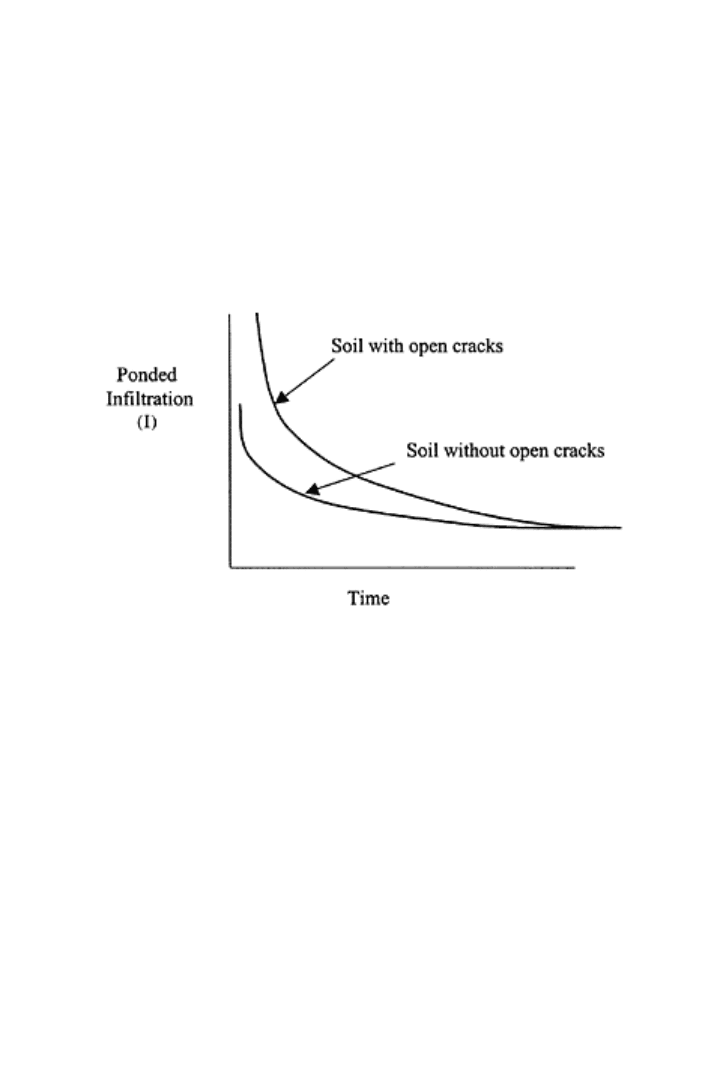
of the cracks due to the swelling of clay under prolonged imbibition (Mitchell and van
Genuchten, 1991).
20.2.4 Solute Transport
The effect of preferential flow channels on solute transport is also well documented in the
literature (Beven and Germann, 1982). A large number of field studies have been
performed in which the effects of preferential flow paths on solute transport were
examined (Steenhuis et al., 1990; Mohanty et al., 1998). Various tracers including
different types of pesticides, and other tracers such as bromide, chloride, and nitrate have
been applied to field plots under different land use and management systems. The
significant
FIGURE 20.3 Schematic of
infiltration-time curves for a soil with
and without cracks.
differences in the transport behavior of these tracers have been observed as a result of
preferential flow paths in general, and biopores in particular. Preferential flow paths are
higher under no-till as macropore or biopore channels are better preserved than in plow-
till soils. More water flow and movement of chemicals at a much faster rate through no-
till soils are also generally observed, which results in less attenuation and higher leachate
concentrations (Isensee et al., 1990).
20.2.5 Models of Macropore Flow
The analysis of water and solute flow through porous media is based on a continuum
approach, which assumes that each variable of interest can be expressed as a continuous
function of time and space. In reality, especially at pore scale, no porous medium is a
continuum, rather, pore spaces and solids exist as separate regions. Therefore, for most
analyses of water and solute flow, soil is considered a continuum at a macroscopic scale
Principles of soil physics 586

or at representative elementary volume (REV). The REV of a soil is a volume that is
large enough so that the inclusion and/or exclusion of a few pores at the edge of REV
does not change the soil properties, and at the same time small enough so that any
variable measured at this scale is a continuous function of space (McCoy et al., 1994).
For a soil with macropore, the two physically based continuum approaches are
available. One of them is the disjoint-volume approach, which treats macropores as not
being part of the porous system. In this approach flow in each macropore or a set of
macropores is described separately and the remaining soil system is dealt with as a
separate continuum. This type of an approach requires three sets of equations to describe
the flow process: (i) through macropores, (ii) through soil matrix, and (iii) exchange of
water and solutes at the interface. The other approach is called a multicontinuum
(multiporosity or multiregion) approach, where different types of pores are treated
separately (or grouped in various categories) and soil mass assumed to be made up of
more than one continuum. If only two continua are considered, the approach is called
dual porosity or bicontinuum or two-region (Gerke and van Genuchten, 1993).
20.3 SWELLING SOILS
Soils that swell when water is added are known as swelling or expansive soils. Swelling
soils typically contain clay minerals that attract and absorb water. When water is added to
these expansive clays, the water molecules are pulled into gaps between the clay plates.
As more water is absorbed, the plates are forced further apart, leading to an increase in
soil pressure or an expansion of the soil’s volume. Soils containing expansive clays
become very sticky when wet and usually are characterized by surface cracks or a
“popcorn” texture when dry. The presence of surface cracks is usually an indication of an
expansive soil. Swelling bedrock contains a special type of mineral called claystone.
Vertisols are dark montmorillonite-rich clays with characteristic shrinking/swelling
properties. This group of soils with a high clay content (>30% to at least 50 cm from the
surface) and in dry state with typical cracks which are at least 1 cm wide and reach a
depth of 50 cm or more, are often also called heavy cracking clay soils. They cover an
area of about 340 Mha worldwide and 9.12 Mha in North America (Table 20.1). The
shrinking of a soil on drying and swelling on wetting has a strong influence on soil
structural and water movement, as well as on stability of pavement and buildings.
Several soils change their volume when their water content (especially close to
saturation) is altered. The increase in volume of such soils with increase in water content
is known as swelling. The porosity of such types of soil depends on water content (Fig.
20.4). The swelling index is the ratio of volume change for a soil saturated with water to
that saturated with a nonpolar liquid. The water content at saturation does not limit the
process of swelling but swelling can continue further, provided more water is available.
The pressure needed to prevent a soil from swelling is called “swelling pressure.” The
swelling pressures can be calculated using double layer theory, and for monovalent
cations the swelling pressure (P) resulting from osmotic pressure differential between the
interparticle midplane can be calculated as follows (Kutilek
Freezing and thawing effects 587
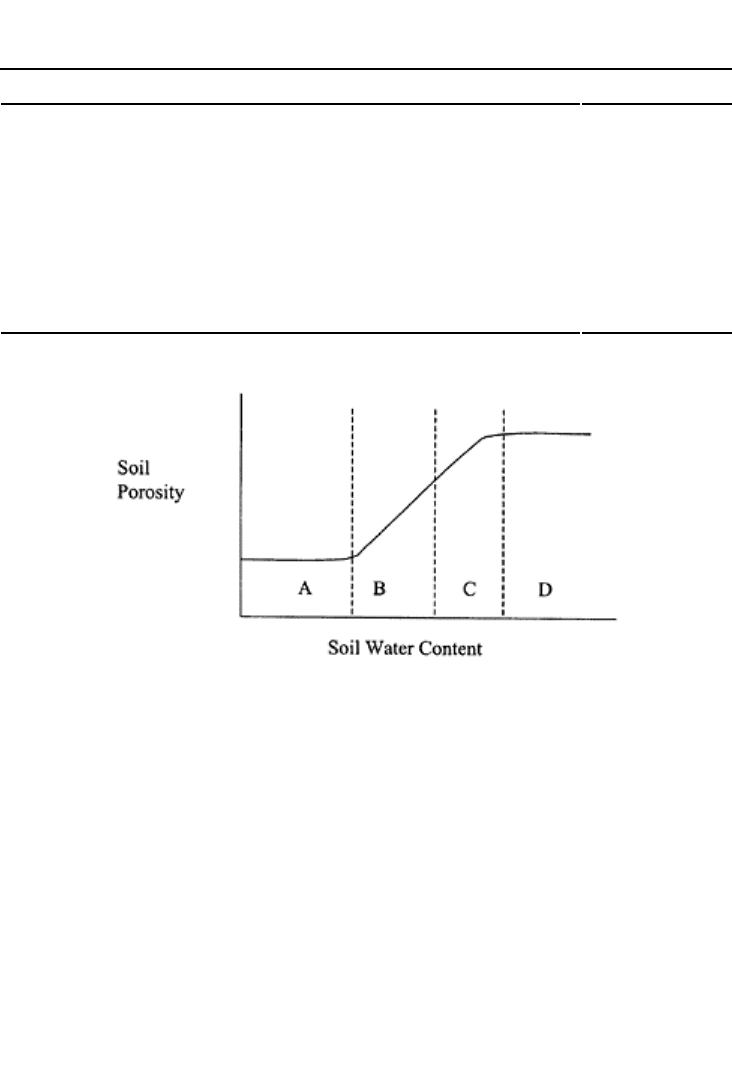
TABLE 20.1 The Distribution of Vertisols Around
the World
Region Area (Mha)
Africa 105
India (including some parts Asia and Far East) 58
Australia 48
Latin America 27
United States (including other parts of North America) 10
Middle East 5.7
Europe 5.4
Source: Modified from Hubble, 1981.
FIGURE 20.4 Schematic of water
concent vs. porosity in swelling soils
for (A) zero change in porosity with
water content change, (B) change
within zero and one, (C) change equal
to one, and (D) zero change.
and Nielsen, 1991):
P=RT(n
c
−2n
0
)
(20.13)
where R is universal gas constant, T is absolute temperature, n
c
is ionic concentration, and
n
0
is the concentration of ambient intermicellar solution. The above model assumes
parallel orientation of clay platelates, which is seldom true in real situations, where a
large number of factors, i.e., silt and sand particles, cations, clay minerals, random
Principles of soil physics 588
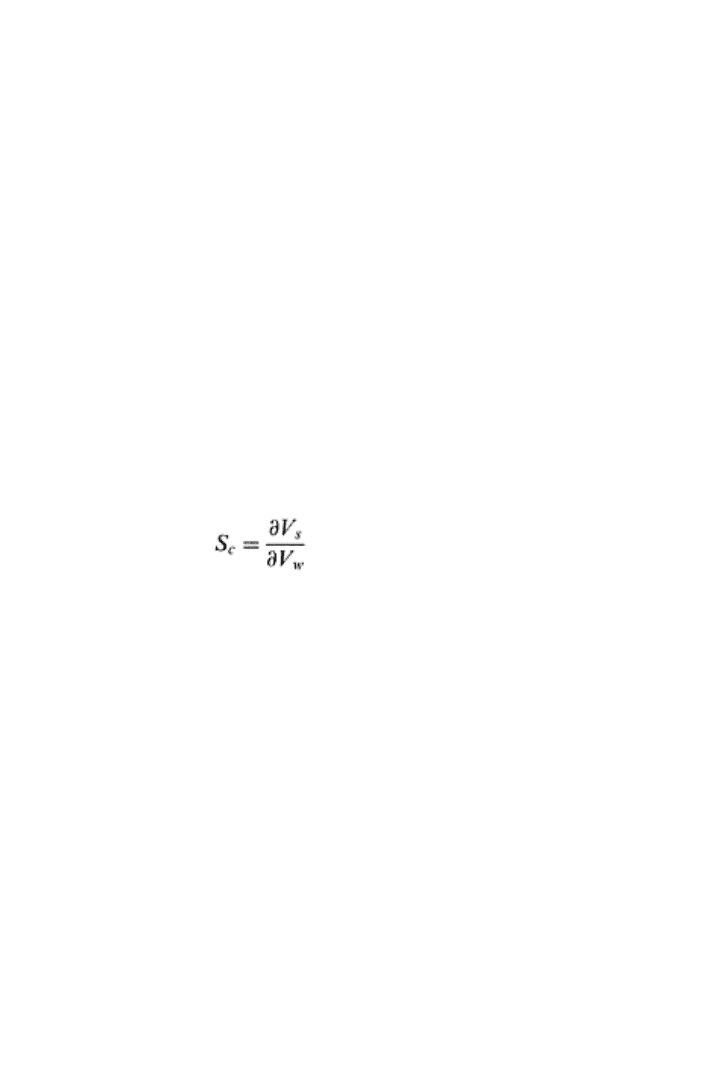
arrangement of clay particles, tactoid formation, and deflocculating can influence soil
behavior during swelling.
20.3.1 Nature of Swelling Clay Soils
Swelling depends upon the clay content, mineralogical composition of clay, and
exchangeable cations. The magnitude of shrinkage is dependent on the amount and type
of clay minerals present. The montmorillonite type clay swells more than chlorite or illite
type clays because monovalent exchangeable cations induce greater swelling than
divalent cations. The swelling of kaolinitic soils is negligible. The physical dimensions,
or volume, of coarse-grained soils, such as sand, are governed solely by loading stresses.
In contrast to this, the volume of a clay soil is governed not only by external stresses but
also by internal stresses. In humid areas natural clay soils with high initial water contents
and which have not previously been subjected to drying or consolidation by loading will
tend to shrink on drying or loading more than they will tend to swell on wetting or
unloading. Soil shrinkage data is presented as specific volume change of the soil as a
function of water content, which is also the reciprocal of bulk density. Since water
content is not evenly distributed in soil profile, the soil drying is considered water lost
from entire soil profile and expressed as a volume-change ratio. From the volume-change
ratio, which is the ratio of change in soil bulk volume and change in volume of water
between saturated and air-dried value, the shrinkage characteristic (S
c
) can be presented
as follows (Mitchell and van Genuchten, 1992)
(20.14)
where V
s
is the volume of soil and V
w
the volume of soil water. Under other climatic
conditions, clays that have been subjected to cyclic moisture change or previously
subjected to higher loading may tend to swell greatly when allowed access to water under
light loading. Their rate of swelling is governed by the rate at which water can move into
the clay, i.e., the permeability of the clay. Because of small pore size and thus their low
permeability, clays may take years to reach new moisture equilibrium conditions. In
saturated clay soils, swelling is given by the change in soil water content:
dq=A
m
dx
(20.15)
where q is the volume of water in unit mass of clay, A
m
is the surface area per unit mass
of clay and x is the mean thickness of the water over surface, i.e., half of water thickness
between two surfaces.
20.3.2 Pressure Potentials in Swelling Soils
The actual swelling in a clayey soil depends on the depth of each layer. The surface layer
of soil swells freely upon wetting, however, deeper layers are prevented by the
confinement of overlying soil, which is known as overburden or envelope pressure. The
total soil water potential (Φ
t
) for an unsaturated swelling soil can be given as
Freezing and thawing effects 589

Φ
t
=Φ
z
+Φ
s
+Φ
a
+Φ
m
(20.16)
and for a saturated swelling soil, it is expressed as
Φ
t
=Φ
z
+Φ
s
+Φ
p
+0
b
(20.17)
where Φ
z
, is gravitational potential, Φ
s
is osmatic potential, Φ
a
is air pressure potential,
Φ
m
is matrix potential, Φ
p
hydrostatic pressure potential, and Φ
b
is overburden pressure
potential (Jury et al., 1991).
20.3.3 Models for Swelling
A two parallel plate model can describe the swelling behavior of montmorillonite sheets
of clay. These two plates are subjected to repulsive and attractive forces (Iwata et al.,
1988). The energy for attraction is caused by adhesive and van der Waals forces, which
depend upon the orientation of the plates and pH of soil solution. When pH decreases the
charges at the edge of the plate becomes positive and edge bonding develops, which is
more like a plate-like arrangement than parallel arrangement of clay particles
(montmorillonites). The repulsive forces between two parallel plates with negatively
charged surfaces consists of forces owing to double layer (short distance) and forces
owing to the differences in electrolyte concentration between the plates and outer solution
(long distance). Since the chemical potential of interlayer is greater than outer solution,
addition of water causes the plates to drift apart till potential difference reaches
equilibrium. The total potential energy is the sum of attractive and repulsive potential
energies, which is not necessarily a monotonic function with distance.
20.3.4 Stages of Swelling
The swelling of plate like clay particles can be described by three stages of swelling
(Norrish, 1972; Kutilek and Nielsen, 1999). The first stage is when the initial distance
between the two plates is less than two nanometers (nm). During this stage, swelling is
opposed by the electrostatic attraction between cations and negatively charged layers.
Swelling beyond 2 nm is possible provided the hydration energy of cation is more than
the energy of attraction. With the addition of water the distance between plates increases
in discrete steps associated with each molecular water layer formed between the sheets.
The swelling continues to the second stage if monovalent cations are present, however, if
divalent and trivalent cations are present, swelling ends at the first stage. In the beginning
of the second stage, the bonding of molecules to solid surface continues as swelling
process continues. The distance between neighboring sheets rises smoothly up to tens of
nm and edge-to-face forces are important for holding sheets together. In the third stage,
the sheets are totally separated and form an arrangement caused by edge-to-face and
edge-to-edge forces. During drying at first the decrease in volume is equal to volume of
water drained (Fig. 20.5) and the degree of
Principles of soil physics 590
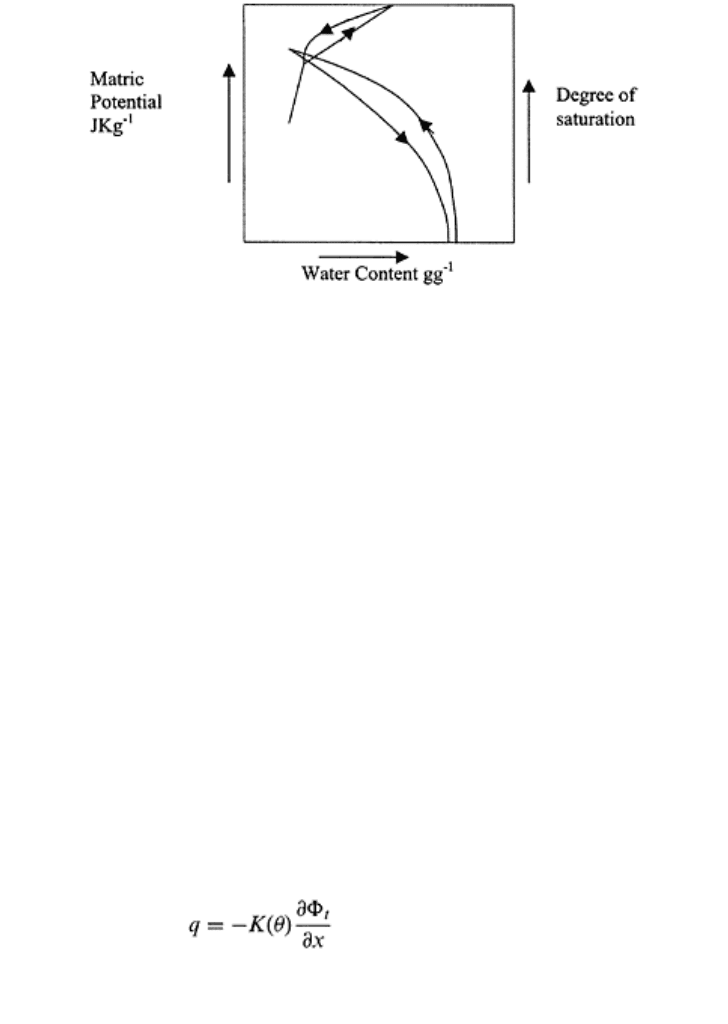
FIGURE 20.5 The stages of drying
during the drying process for a block
containing 64% clay. (Modified from
Holmes, 1955.)
saturation remains fairly constant. However, in the second stage, volume decreases less
rapidly than water content as air starts entering the soil.
20.3.5 Flow in Swelling Soils
Darcy’s law, Darcy–Buckingham’s law, and Richards’ equation describe the flow in
nonswelling soils. These equations along with continuity and conservation equations are
described in Chapters 12 and 13. The theory of flow in swelling soils for a one-
dimensional deformation using Darcy’s equation needs to be modified and hydraulic
conductivity redefined to relate the rate of water flow to the solid phase (Smiles and
Rosenthal, 1968; Philips, 1969). Some of the possible reasons, which limit their
application on swelling soil are (i) three-dimensional macroscopic volume change, (ii)
swelling soils are structured and contain aggregates and voids and are highly permeable
when dry and impermeable when wet depending upon the rate at which soil swells and
voids close and (iii) profiles are structural and due to self weight, bulk density increases
with depth (Smiles, 1981).
In swelling soils during unsteady vertical water flow, the soil solids are in motion,
therefore Darcy’s equation essentially describes the volume flux of water relative to solid
framework for a water content (θ) dependent hydraulic conductivity (K) as follows
(20.18)
The total potential (Φ
t
) of vertical system for one-dimensional flow for solute-free water
can be written as follows:
Φ
t
=Φ
b
+Φ
mp
−Φ
z
(20.19)
Freezing and thawing effects 591
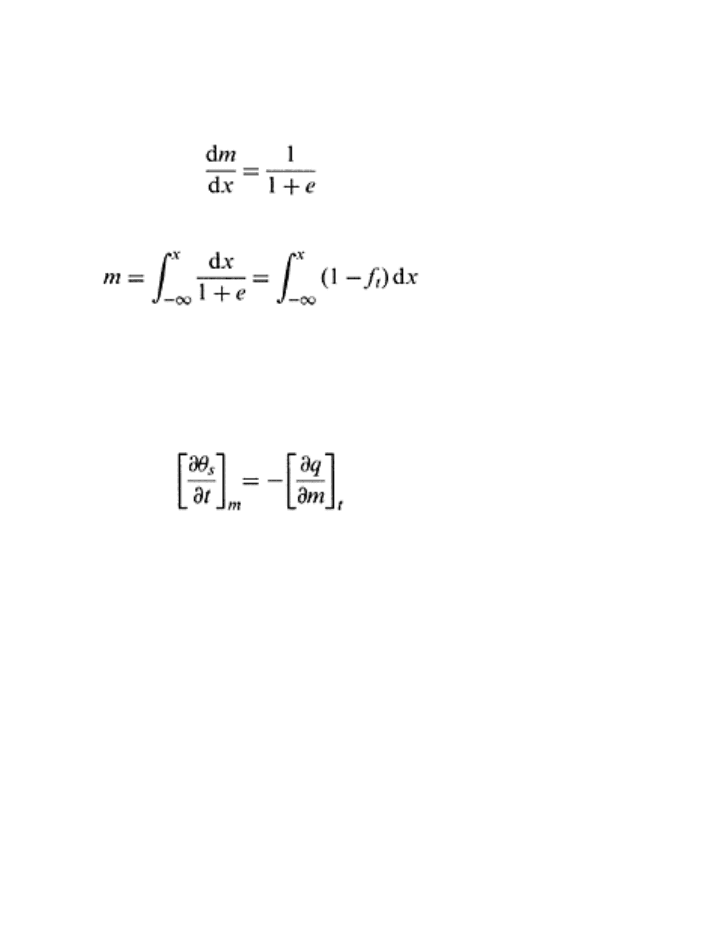
where Φ
b
is overburden potential and Φ
mp
is unloaded moisture potential, (Φ
b
+Φ
mp
) can
be measured by a tensiometer.
The unsteady flow problems can be considered in a framework of physical space or
material coordinate. Therefore, instead of Euler’s coordinate system, Lagrange’s
coordinates need to be considered, which is arithmetically more succinct where material
coordinate is defined as follows (Smiles and Rosenthal, 1968)
(20.20)
or
(20.21)
where m is cumulative volume of the solid component defined in length scales. Equation
(20.21) states that the ratio of material coordinate m to Eulerian coordinate x equals the
ratio of the volume of solid phase to total volume of soil. The e is void ratio, which is the
ratio of volume of void and volume of solid. For saturated soils, e=θ
s
and the equation of
continuity of water can be written as follows:
(20.22)
Equations (20.18), (20.19), (20.20), and (20.22) can be combined to yield a flow equation
for swelling soils. The combined equation can be solved for known K(θ), Φ(θ)
relationship and e and θ values for a given f
t
.
20.3.6 Measurement of Swelling
Assuming that soil in the field is homogeneous, saturated, and has onedimensional
drainage and compression, the test soil core collected from the field is trimmed and its
weight and height are determined. This information is used to obtain the initial volume,
initial density, void ratio, water content, and degree of saturation. To measure expansion
characteristics, the soil sample is saturated under full load then allowed to expand after
that seating load of 0.025 kg cm
−2
is applied and the initial dial reading on a
consolidometer are recorded. Then fill the pan in which the consolidometer stands with
water and let the sample saturate. As the sample expands, increase the load as required
holding the sample at its original height. Then gradually (once every 24 hours or longer)
reduce the load to 1/2, 1/4, and 1/8 of maximum load, and finally, to the seating load.
Measure the height of the soil sample with each load.
Principles of soil physics 592

20.4 SALT-AFFECTED SOILS
Salt-affected soils have a high concentration of soluble salts. Such soils are of three
types: saline soils, alkaline soils, or saline-alkaline soils. Saline soils are those which
have an electrical conductivity (EC) of the saturation soil extract of more than 4dSm
−1
at
25°C, exchangeable sodium percentage (ESP) less than 15, and pH about 8.5 (Richards,
1954). The ESP is the characteristic of alkalinity or sodic soils. Saline-alkali soils have
EC greater than 4 dSm
−1
and ESP greater than 15. Electrical conductivity is measured in
units of Siemens m
−1
(Sm
−1
). One S m
−1
equals one mho m
−1
. These soils require
treatment with gypsum to reduce high ESP before leaching and prevent dispersion.
Nonsaline alkali soils have ESP greater than 15, salinity less than 4dSm
−1
, and high pH
(8.5–10). These soils are also known as solonetz or black alkali. The EC value of 4 dSm
−1
is used worldwide for defining salinity although the terminology committee of the Soil
Science Society of America has lowered the boundary between saline and nonsaline soils
to 2 dSm
−1
in the saturation extract (Abrol et al., 1988). Excess salts keep the clay in a
flocculated state and the soils have better structure and permeability to water than
nonsaline soils (Abrol et al., 1988). Salt-affected soils may be primary or secondary.
Primary salinization is caused by natural factors (e.g., parent material, drainage, ground
water quality, etc.). In contrast, secondary salinization is caused by anthropogenic factors
such as excessive irrigation with poor quality water and inadequate drainage (Fig. 20.6).
Saline soils cover about 190 Mha areas worldwide and about 0.13 Mha in North
America (Oldeman, 1994·http://www.fao.org/) (Fig. 20.7). Soluble salts present in saline
soils are the chlorides and sulfates of sodium, calcium, magnesium, and nitrates, with
sodium and chloride being the dominant ions, calcium and magnesium basically enough
to meet the nutritional needs of crops. Saline soils show a considerable diversity in
hydrological, physical, and chemical properties and can be calcium, sodium, or
magnesium dominated, with a tendency toward structural degradation (which depends on
the presence or absence of calcium). Under low rainfall and high evaporation conditions,
salts present in the soil solution precipitates as white efflorescence, salt crusts,
nonaggregated brown powder, black salt deposits, evaporative salt crystals, etc. Many
saline soils contain high amount of gypsum (CaSO
4
, 2H
2
O) and soluble carbonates
(Abrol et al., 1988).
Freezing and thawing effects 593
